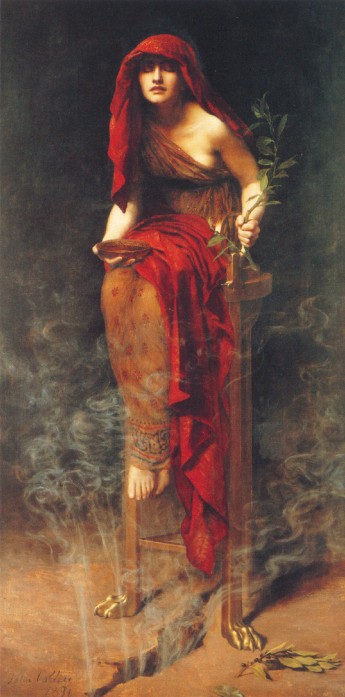PRIESTESS OF DELPHI
John Collier
27 January 1850 – 11 April 1934
1891
The Delphic oracle may have been present in some form from 1400 BC, in the middle period of Mycenaean Greece (1600–1100 BC). There is evidence that Apollo took over the shrine with the arrival of priests from Delos in the 8th century, from an earlier dedication to Gaia.
The 8th-century reformulation of the Oracle at Delphi as a shrine to Apollo seems associated with the rise in importance of the city of Corinth and the importance of sites in the Corinthian Gulf.
The earliest account of the origin of the Delphic oracle is provided in the Homeric Hymn to Delphic Apollo, which recent scholarship dates within a narrow range, c. 580–570 BC. It describes in detail how Apollo chose his first priests, whom he selected in their “swift ship”; they were “Cretans from Minos’ city of Knossos” who were voyaging to sandy Pylos.
But Apollo, who had Delphinios as one of his cult epithets, leapt into the ship in the form of a dolphin (delphys”, gen. “delphinos). Dolphin-Apollo revealed himself to the terrified Cretans, and bade them follow him up to the “place where you will have rich offerings”.
The Cretans “danced in time and followed, singing Iē Paiēon, like the paeans of the Cretans in whose breasts the divine Muse has placed “honey-voiced singing”. “Paean” seems to have been the name by which Apollo was known in Mycenaean times.
G.L. Huxley observes, “If the hymn to (Delphic) Apollo conveys a historical message, it is above all that there were once Cretan priests at Delphi.” Robin Lane Fox notes that Cretan bronzes are found at Delphi from the eighth century onwards, and Cretan sculptures are dedicated as late as ca 620–600 BC:
“Dedications at the site cannot establish the identity of its priesthood,” he observes, “but for once we have an explicit text to set beside the archaeological evidence.” An early visitor to these “dells of Parnassus”, at the end of the eighth century, was Hesiod, who was shown the omphalos.
There are also many later stories of the origins of the Delphic Oracle. One late explanation, which is first related by the 1st century BC writer, Diodorus Siculus, tells of a goat herder named Coretas, who noticed one day that one of his goats, who fell into a crack in the earth, was behaving strangely.
Upon entering the chasm, he found himself filled with a divine presence and could see outside of the present into the past and the future. Excited by his discovery he shared it with nearby villagers. Many started visiting the site to experience the convulsions and inspirational trances, though some were said to disappear into the cleft due to their frenzied state.
Priestess Of Delphi Origins
A shrine was erected at the site, where people began worshiping in the late Bronze Age, by 1600 BC. After the deaths of a number of men, the villagers chose a single young woman as the liaison for the divine inspirations. Eventually, she spoke on behalf of the gods.
According to earlier myths, the office of the oracle was initially possessed by the goddesses Themis and Phoebe, and the site was initially sacred to Gaia. Subsequently, it was believed to be sacred to Poseidon, the “Earth-shaker” god of earthquakes.
During the Greek Dark Age, from the 11th to the 9th century BC, a new god of prophecy, Apollo, allegedly seized the temple and expelled the twin guardian serpents of Gaia, whose bodies he wrapped around the caduceus.
Later myths stated that Phoebe or Themis had “given” the site to Apollo, rationalizing its seizure by priests of the new god, but presumably, having to retain the priestesses of the original oracle because of the long tradition. Apparently, Poseidon was mollified by the gift of a new site in Troizen.
Diodorus also explained how, initially, the Pythia was an appropriately clad young virgin, for great emphasis was placed on the Oracle’s chastity and purity to be reserved for union with the god Apollo.
“Priestess of Delphi” Source: Wikipedia.





